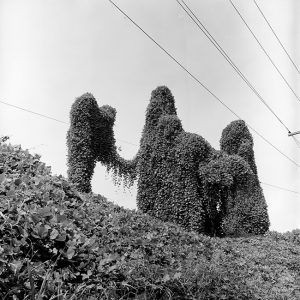calsfoundation@cals.org
Kudzu
Kudzu (Pueraria lobata) is an invasive vine characterized by aggressive growth and clusters of grape-scented purple flowers. It was recognized as a weed in 1972 by the U.S. Department of Agriculture (USDA). A native plant of Asia, kudzu has been used for over two millennia in Asian cooking and medicine. Kudzu was introduced to the United States at the Philadelphia Centennial Exposition (1876) and to southerners at the New Orleans Exposition (1884–1886).
Kudzu’s foothold in the American South is largely the result of the efforts of Charles Pleas, Channing Cope, and the Soil Conservation Service (SCS). Pleas owned Glen Arden Nursery in Chipley, Florida, along with his wife, Lillie. After Pleas discovered kudzu’s usefulness for livestock forage and as a shade plant, the nursery sold it by mail all across the South in the early decades of the twentieth century.
Cope, an agricultural writer for the Atlanta Journal Constitution, championed the planting of kudzu as a cash crop for the South, proclaiming, “Cotton isn’t king here anymore. Kudzu is king.” Cope founded the Kudzu Club of America in 1943, which had 20,000 members during its heyday.
Cope’s efforts to promote the cultivation of kudzu were aided by the federal government in the 1930s and 1940s. The Soil Conservation Service launched a planting campaign across the South in 1935 and offered landowners $8 an acre to plant kudzu. Cultivation increased from 10,000 to 500,000 acres within a decade.
By 1952, the SCS had stopped recommending the planting of kudzu, but the damage inflicted to the southern landscape by the plant’s aggressive growth was already significant. Kudzu is estimated to cover between two and seven million acres of land in the southern United States and has pushed its way into other regions, appearing as far northwest as Oregon and Canada.
Kudzu’s impact on Arkansas has been less significant than in Mississippi and Alabama. At present, kudzu is not an “invasive species of concern” for Arkansas; while kudzu is “locally abundant,” it is not considered a “major forest management concern” for the state, unlike a number of other invasive plant species, including Japanese climbing fern and cogongrass. Kudzu’s greatest impact in Arkansas is along Crowley’s Ridge, which is highly susceptible to erosion.
Attempts to control kudzu in the United States reached an expense of more than $6 million annually at the start of the twenty-first century. Time magazine labeled the introduction of kudzu to the United States as one of the worst ideas of the twentieth century, along with asbestos and DDT. Scientists at the Earth Institute at Columbia University have suggested that kudzu is hastening global warming due to the large amounts of nitrogen the vine adds to soil.
Although kudzu has been repudiated for its “rampant invasive growth,” it has become a symbol of southern life and culture, assuming “almost mythic cultural significance,” according to C. Ritchie Bell and Charles Reagan Wilson’s writing in The New Encyclopedia of Southern Culture. The plant has entered mainstream media, inspiring film titles, band names, a comic strip, and other popular culture references.
For additional information:
“The 100 Worst Ideas of the Century.” Time (June 14, 1999): 37.
Alderman, Derek H. “Channing Cope and the Making of a Miracle Vine.” Geographical Review 94 (April 2004): 157–177.
Baldwin, Juanitta. Kudzu Cuisine: Festive Cookery to Delight the Adventurous and Intrigue the Skeptics. Virginia Beach, VA: Suntop Press, 1999.
———. Kudzu in America. Virginia Beach, VA: Suntop Press, 2003.
Bell, C. Ritchie, and Charles Reagan Wilson. “Kudzu.” In The New Encyclopedia of Southern Culture, Vol. 8: Environment, edited by Martin Melosi. Chapel Hill: University of North Carolina Press, 2007.
Bragg, Don C. “Forests and Forestry in Arkansas during the Last Two Centuries.” In National Proceedings: Forest and Conservation Nursery Associations, edited by L.E. Riley et al.. Fort Collins, CO: 2010. Online at http://www.fs.fed.us/rm/pubs/rmrs_p065/rmrs_p065_003_009.pdf (accessed October 19, 2021).
French, Warren, ed. The South and Film. Jackson: University Press of Mississippi, 1981.
Hinman, Kristen. “Kudzu.” American History 46 (June 2011): 38–45.
Horn-Muller, Ayurella. Devoured: The Extraordinary Story of Kudzu, the Vine That Ate the South. Baton Rouge: Louisiana State University Press, 2024.
Klingman, Gerald.“Kudzu or Mile-a-Minute Vine.” University of Arkansas Division of Agriculture Research and Extension, Cooperative Extension Service. http://www.arhomeandgarden.org/plantoftheweek/articles/Kudzu/htm (accessed October 19, 2021).
Reilly, Michael. “Invasive Vine is a Prodigious Polluter.” New Scientist 195 (August 11, 2007): 13.
Thomas, Phillip Drennon. “Invasive and Alien Species (Floral and Faunal).” In The New Encyclopedia of Southern Culture, Vol. 8: Environment, edited by Martin Melosi. Chapel Hill: University of North Carolina Press, 2007.
Lisa Speer
Arkansas History Commission
 Science and Technology
Science and Technology Kudzu
Kudzu 



GOATS. Six pygmy goats make such a hole in overwhelming plants. You keep them rotated and in a couple of years, kudzu is gone.